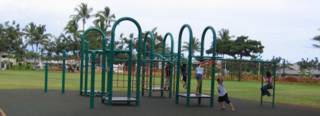Are Our Playground Safety Standards Worthwhile?
I found this book a very interesting read. The Austrailian Playground Standard has been unchanged for 20 years now and there's no regulatory mechanism in existence. This book claims 100,000 injuries a year in a country with a population around the same size of California. Hmmm... maybe these pesky playground standards do make our playgrounds safer.
Slippery slide in playground safety
By Tiy Chung
April 19, 2004
CHILDREN love the playground. It's a place where they can explore, take risks and have fun. But they can also be very dangerous places.
According to a new book on playground safety and equipment, Playgrounds the Australian Way, by Jack Grealy, up to 100,000 children are injured in playgrounds each year.
Grealy, who has designed and built children's playgrounds for the past 30 years, believes the situation in Australian playgrounds is appalling. "Some of the things that you see in playgrounds are enough to make you weep because you know that children must get hurt," Grealy says.
His book is exhaustive in its analysis of playground equipment and rates each in terms of its play value. It also suggests the best design standards and risk-prevention strategies for them.
According to the book, the No.1 cause of most playground injuries comes from falling off equipment. This comes from the poor design of the equipment and the inappropriate surfaces that many playgrounds are built on.
David Eager, of the faculty of engineering at the University of Technology, Sydney, is a member of the Australian standards committee on playgrounds and sits on the board of Kidsafe NSW. Eager says not enough is being done to prevent fall-related injuries. "In my experience there is a really low compliance with the Australian standards for impact attenuation," he says. "If we could get compliance with that standard in playgrounds, the incidence of injuries or admittance to emergency departments would drop significantly. I go around and measure these playgrounds and over 90 per cent are failing."
Eager believes the technology is out there to fix the problem. But many councils just aren't testing the quality of the surfaces on to which children fall.
"You get these fly-by-night undersurfacing companies out to make a quick buck and they've skimped on this and that, and used cheap materials," he says. "You see it all: big concrete slabs, buried pipes, bits of steel and tree roots, and these things are inevitably right where the kids will fall."
Grealy argues that a review of the Australian standard would go a long way to reducing the number of injuries every year. "The Australian standards on playgrounds are 20-odd years old," he says. "They were not particularly good then and they are not particularly good now."
The Australian Standard (No.4422) for falls is "1000 head injury criteria" (HIC) and a "200 times gravity max" (200G). Although that may not mean much to anyone but accident specialists, it is double what it should be.
"Even at playgrounds that do comply with the Australian standard, we're still getting unacceptable, severe injuries," he says. "If a child has a frontal lobe impact, at these current rates they will die." According to Eager, the standard was set up to prevent people dying when they fall but was never intended to stop long bone injuries or the types of injuries that send children to hospital.
There is a big push by Kidsafe and other organisations to lower the standard to half what it is now, which they argue would reduce the injury rate and severity of injuries significantly.
Grealy and Eager also believe that the playground industry should be regulated to stop the use of shoddy equipment and unsafe practices. "The major problem I think with playgrounds is that there is no regulatory body that says 'thou shalt not put kids at unnecessary risk'," Grealy says.
"The playground industry is self-governing and I think a lot of manufacturers are either oblivious to the injuries that their equipment causes or they are indifferent.
"What many suppliers have failed to grasp is innovative designs and colourful creations do not automatically meet the standards that provide opportunites for injury-free play."
Eager says the problem of regulation could be fixed overnight with a bit of lateral thinking.
"All you need to do is say a playground is a place of work and therefore falls under the Occupation, Health and Safety Act, and WorkCover would be involved," he says.
"Everywhere that we have a playground there is somebody who works for either the Department of Education, the local government or some childcare centre and because they're employed it becomes a place of work."
Grealy says that designing playgrounds is all about risk management.
For example, just as you would not leave a pot of hot water at the front of a stove where a child can pull it down, so playground equipment should be designed with common sense in mind.
"You would say on the face of it that playground standards in Australia look pretty good," Grealy says. "But when you look at the statistics, with 100,000 kids injured every year, and you then look at the costs involved in treating injured children, there's a hell of a lot of money involved. "I don't see any point in hurting kids unnecessarily."

